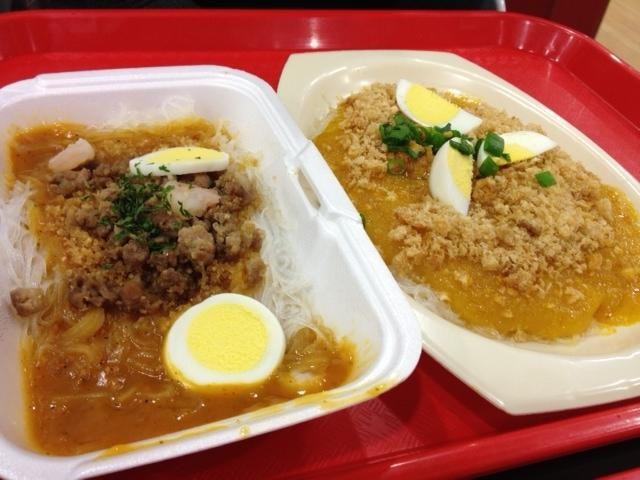
Imagine if McDonald's bought out Burger King and they existed under the same roof like those Yum Brand hybrid restaurants with KFC, Pizza Hut, and Taco Bell sharing the same counter. That's essentially what's happened with Jollibee and Red Ribbon in Anaheim. They are two former competitors turned uneasy partners living together like a married couple who sleep in separate bedrooms. You can go into Jollibee, then walk a few feet without tripping on any barriers and be in Red Ribbon.
If there were a Venn diagram that charts their divergent menus (Jollibee is fast food known for their fried chicken; Red Ribbon is a bakery beloved for their mango chiffon cakes), you'd discover that at the intersection, there's exactly one shared dish: the pancit palabok.
]
Pancit palabok, which is best described as the Pinoy equivalent of pad
Thai, is part of a subclass of food called merienda, essentially a snack
in-between meals. If there were one national dish that the Phillipines
should promote to popularize their cuisine to those who might be
unacquainted with its splendor, it's the pancit palabok. And in Red
Ribbon and Jollibee's they've already got willing ambassadors. Their
dueling versions are, however, more different than they are the same.
Red Ribbon's takes a lot longer to prepare, and from what I observed, is
made to order. I actually had to wait upwards of about five minutes for my
noodles to be boiled from scratch. Jollibee's pancit palabok (now dubbed Fiesta
Noodles) were served to me almost the instant I said I wanted it.
Red Ribbon's was served on an oval foam plate; Jollibee's, in a foam box.
Both require satchels of prepackaged lemon juice to be poured over the
meal and mixed in before eating; but Red Ribbon's sauce was one-noted,
salty with hints of shrimp, and somewhat oilier. Jollibee's was more
rounded with a sweetness layered on top of the savory, the whole mass
satisfying to slurp.
Jollibee's also has more meat (in the form of ground pork) where Red
Ribbon's has more crunch (in the form of crushed pork rinds). But it's
in the rice noodle that the two dishes further diverge. Red Ribbon's
strands were overcooked and clumpy; Jollibee's noodles, despite being
pre-prepared, were paradoxically better, each hair-thin strand still individual
and with a soft but jiggly bite.
Which one, as a consumer, should you try? I'd say Jollibee's; but why not both. Just walk over, like, 10 feet.
Follow Stick a Fork In It on Twitter @ocweeklyfood or on Facebook! And don't forget to download our free Best Of App here!
Before becoming an award-winning restaurant critic for OC Weekly in 2007, Edwin Goei went by the alias “elmomonster” on his blog Monster Munching, in which he once wrote a whole review in haiku.


I just visited a post similar to this one, but the material wasn’t as engaging as what’s here.